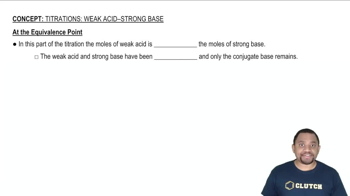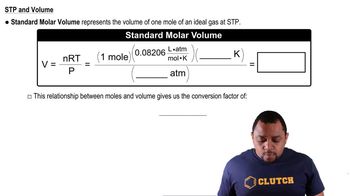Consider the titration of a 25.0-mL sample of 0.115 M RbOH with 0.100 M HCl. Determine each quantity. b. the volume of added acid required to reach the equivalence point
Ch.18 - Aqueous Ionic Equilibrium
Chapter 18, Problem 77b
Consider the titration of a 20.0-mL sample of 0.105 M HC2H3O2 with 0.125 M NaOH. Determine each quantity. b. the volume of added base required to reach the equivalence point
 Verified step by step guidance
Verified step by step guidance1
Determine the moles of acetic acid (HC2H3O2) present in the solution using the formula: \( \text{moles} = \text{concentration} \times \text{volume} \).
Use the balanced chemical equation for the reaction: \( \text{HC}_2\text{H}_3\text{O}_2 + \text{NaOH} \rightarrow \text{NaC}_2\text{H}_3\text{O}_2 + \text{H}_2\text{O} \). Note that the mole ratio between HC2H3O2 and NaOH is 1:1.
Since the mole ratio is 1:1, the moles of NaOH required to reach the equivalence point will be equal to the moles of HC2H3O2 calculated in the first step.
Calculate the volume of NaOH solution needed using the formula: \( \text{volume} = \frac{\text{moles}}{\text{concentration}} \).
Substitute the moles of NaOH and its concentration into the formula to find the volume of NaOH required to reach the equivalence point.

Verified video answer for a similar problem:
This video solution was recommended by our tutors as helpful for the problem above.
Video duration:
3mWas this helpful?
Key Concepts
Here are the essential concepts you must grasp in order to answer the question correctly.
Titration
Titration is a quantitative analytical technique used to determine the concentration of a solute in a solution. It involves the gradual addition of a titrant (a solution of known concentration) to a sample until a reaction reaches its equivalence point, where the amount of titrant equals the amount of substance in the sample. This process is often monitored using indicators or pH meters to identify the endpoint.
Recommended video:
Guided course

Acid-Base Titration
Equivalence Point
The equivalence point in a titration is the stage at which the amount of titrant added is stoichiometrically equivalent to the amount of substance present in the sample. At this point, the reaction between the acid and base is complete, and the pH of the solution changes significantly. Understanding the equivalence point is crucial for calculating the volume of titrant needed to neutralize the analyte.
Recommended video:
Guided course

At the Equivalence Point
Molarity and Volume Relationship
Molarity (M) is defined as the number of moles of solute per liter of solution. In titration calculations, the relationship between the molarity and volume of the acid and base is used to determine the volume of titrant required to reach the equivalence point. The formula M1V1 = M2V2 relates the molarity and volume of the acid (M1, V1) to the molarity and volume of the base (M2, V2), allowing for the calculation of the unknown volume.
Recommended video:
Guided course

Standard Molar Volume
Related Practice
Textbook Question
Textbook Question
Consider the titration of a 25.0-mL sample of 0.115 M RbOH with 0.100 M HCl. Determine each quantity. c. the pH at 5.0 mL of added acid
Textbook Question
A 30.0-mL sample of 0.165 M propanoic acid is titrated with 0.300 M KOH. Calculate the pH at each volume of added base: 0 mL, 5 mL, 10 mL, equivalence point, one-half equivalence point, 20 mL, 25 mL. Sketch the titration curve.
Textbook Question
A 30.0-mL sample of 0.165 M propanoic acid is titrated with 0.300 M KOH. Calculate the pH at each volume of added base: 0 mL.
Textbook Question
A 30.0-mL sample of 0.165 M propanoic acid is titrated with 0.300 M KOH. Calculate the pH at each volume of added base: 5 mL.
